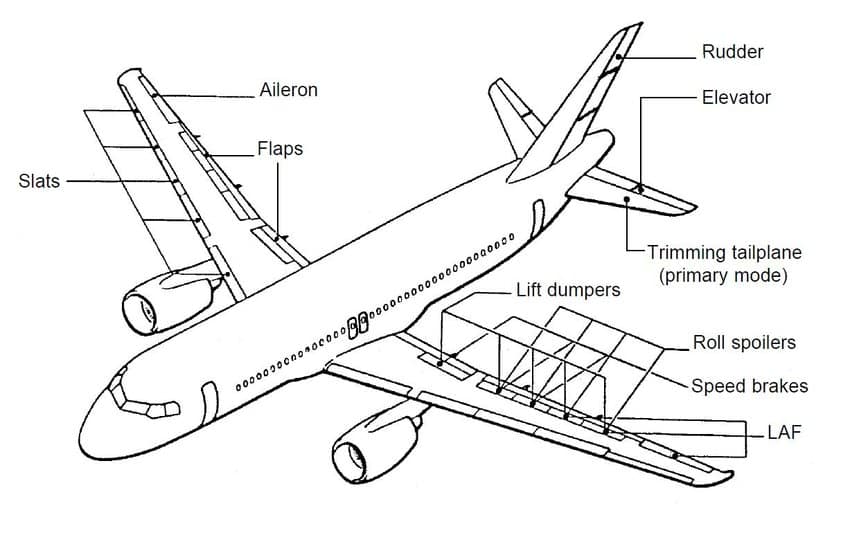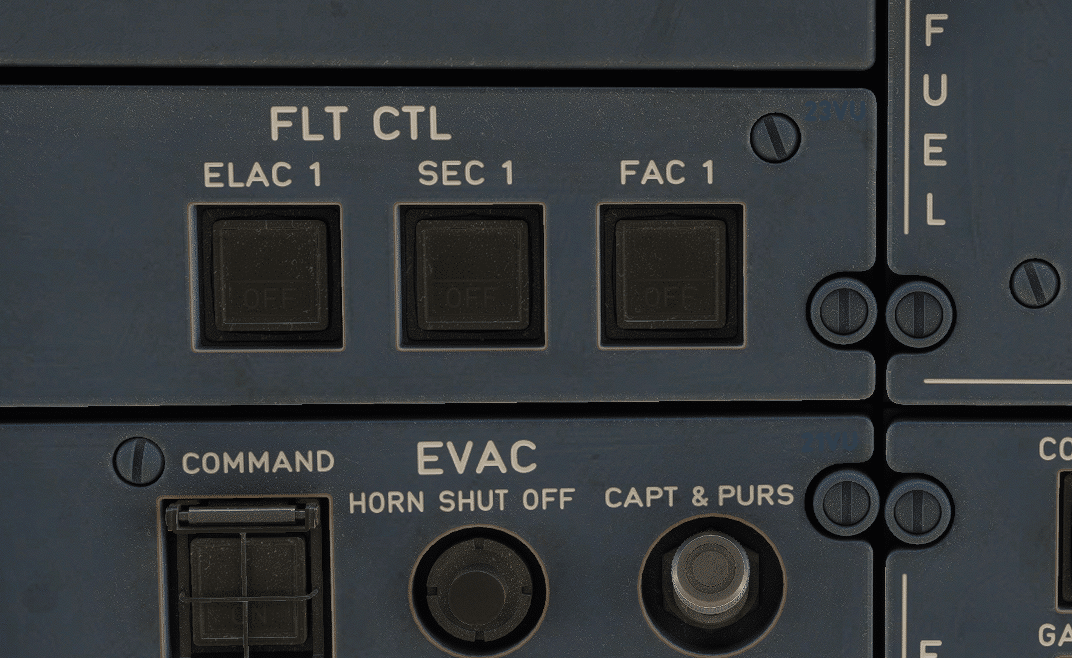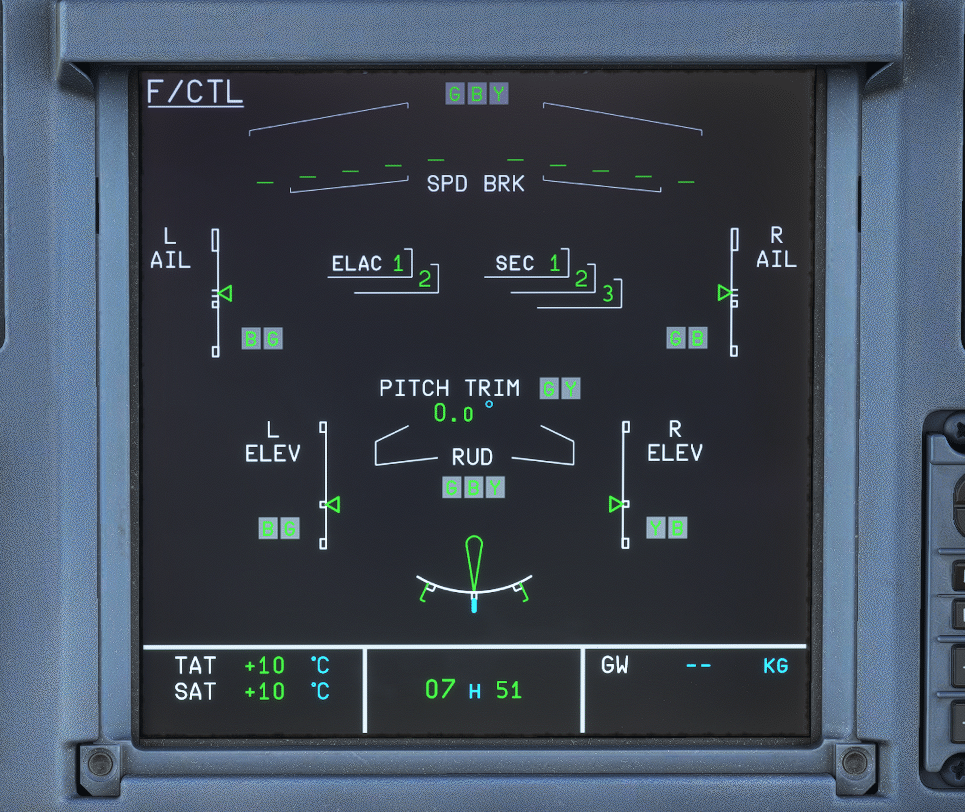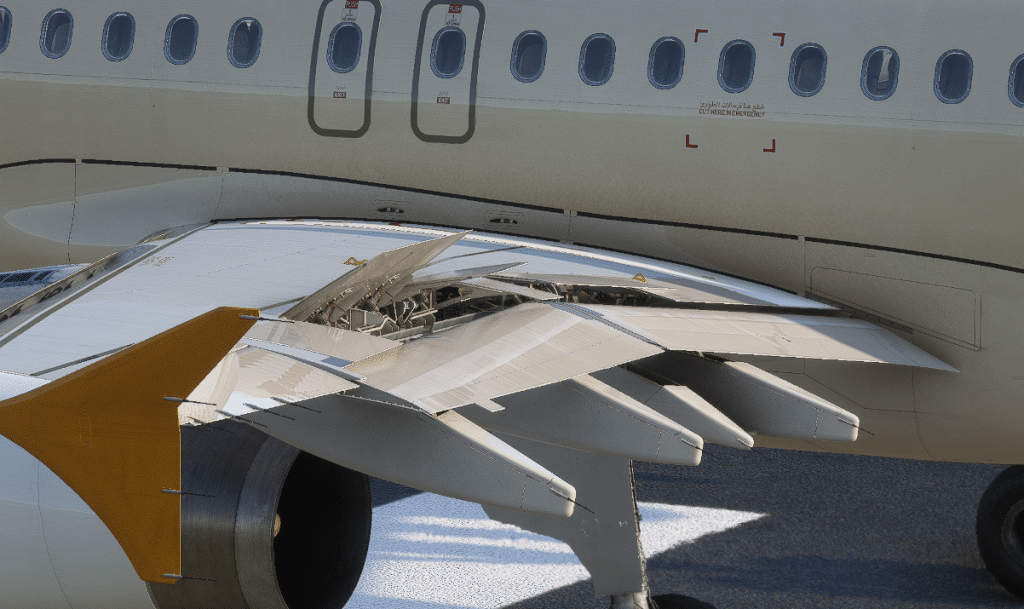The A320 Flight Controls of the Airbus A320’s fly-by-wire flight control system redefined modern airliner handling when it entered service in 1988. Unlike traditional mechanical linkages, the A320 translates pilot inputs into electronic signals processed by flight control computers, which in turn command hydraulic actuators that move the control surfaces.
According to the Airbus A320 FCOM, this digital interface ensures precision, efficiency, and protection — the hallmarks of Airbus flight philosophy. The A320 flight controls utilize various laws, including normal law, alternate law, and direct law, which dictate the operation of the elevator, ailerons, and spoilers.
These laws enable the aircraft to manage stability and safety by automatically adjusting the flight parameters based on data received from the elevator computer and other flight control computers. The autopilot function further enhances the stability of the Airbus A320 by providing continuous adjustments to maintain speed and altitude. Let’s take a closer look at the use of flight controls and how computers process these information and data.
The Architecture of A320 Flight Controls
The Electrical Flight Control System (EFCS) governs all primary and secondary control surfaces:
- Primary Controls: Elevators, ailerons, rudder, and trimmable horizontal stabilizer (THS)
- Secondary Controls: Slats, flaps, and spoilers
The A320 AFM lists three main computer types that manage these functions:
- 2 ELACs (Elevator Aileron Computers)
- 3 SECs (Spoiler Elevator Computers)
- 2 FACs (Flight Augmentation Computers)
Each computer has overlapping responsibilities, ensuring redundancy and fault tolerance — a design that allows safe operation even in the event of multiple system failures.

Primary Flight Control Computers
ELAC (Elevator Aileron Computer)
ELACs are the core logic brains for pitch and roll.
They process side-stick inputs, compute commands, and send signals to:
- Elevators and ailerons for pitch and roll control
- Trimmable horizontal stabilizer (THS) for automatic trim management
If both ELACs fail, control reverts to SECs in degraded modes.
SEC (Spoiler Elevator Computer)
SECs back up the ELACs and command:
- Spoilers (for roll control and speed reduction)
- Elevators (in backup mode)
- Ground spoiler and speed brake logic
Each SEC also contributes to flight control reconfiguration — key during alternate and direct law transitions.
FAC (Flight Augmentation Computer)
FACs enhance lateral stability and safety, controlling:
- Rudder trim and travel limitation
- Yaw damping
- Turn coordination
- Flight envelope and windshear detection
The FACs also interact with the Auto Flight System (ATA 22) for yaw autopilot functions and flight envelope monitoring.

Flight Control Laws
The A320 operates under three flight control laws that determine how pilot inputs are interpreted.
Normal Law
This is the standard mode for all flight phases, providing:
- Full flight envelope protection
- Load factor limitation
- High angle-of-attack (Alpha) protection
- Pitch attitude and bank angle protection
- Overspeed and pitch trim prevention
In this mode, the aircraft cannot be overstressed — a key Airbus design philosophy noted in the FCTM.
Alternate Law
Activated after multiple computer or system failures.
- Some protections are lost (e.g., load factor and alpha protection).
- Roll and pitch are computed differently, with reduced redundancy.
Direct Law
A pure manual mode where side-stick inputs directly drive control surfaces without computer augmentation.
As stated in the A320 Basics manual, pilots should restrict full control surface deflection below VA (Design Maneuvering Speed) when in direct law to avoid overstressing the airframe.
Mechanical Backup
If all computers fail, basic control remains available:
- Pitch via the trim wheel
- Yaw via rudder pedals (hydraulic control)
Though limited, this ensures minimal controllability for recovery or descent.
Primary and Secondary Control Surfaces
| Surface | Control | Computer(s) | Law/Backup Role |
|---|---|---|---|
| Elevators | Pitch | ELAC / SEC | Normal + Backup |
| Ailerons | Roll | ELAC | Normal |
| Rudder | Yaw | FAC | Normal / Mechanical backup |
| THS | Trim | ELAC | Automatic Trim |
| Flaps/Slats | Lift augmentation | SFCC | Managed via FLAP/SLAT lever |
| Spoilers | Roll, braking, speed | SEC | Roll assist + ground spoiler |
The Flight Crew Operating Manual (FCOM) emphasizes that each actuator is hydraulically powered and commanded via separate control channels, ensuring fail-safe operation even under hydraulic or computer degradation.
Fly-by-Wire and Protections
The A320’s fly-by-wire architecture provides active protections unavailable in mechanical systems:
- Pitch Protection: Automatic trim maintains 1g flight path stability
- Bank Angle Protection: Limits roll to 67°, returning to 33° when released
- High Speed Protection: Prevents Mach/VMO exceedance
- Alpha Floor: Automatically applies TOGA thrust at critical angle-of-attack
These protections are computed by ELACs and FACs, verified by monitoring channels, and displayed via ECAM messages on the Electronic Instrument System (EIS).
Pilot Interface and ECAM Integration
The pilot’s interface with the flight control system occurs primarily through:
- Side-stick controllers (one per pilot, not mechanically linked)
- ECAM (Electronic Centralized Aircraft Monitoring) for status and fault messages
- Flight Mode Annunciator (FMA) for law and autopilot status
All flight control law transitions and faults (e.g., “ALTN LAW – PROT LOST”) are presented on ECAM, allowing pilots to react swiftly according to procedures defined in the FCTM and AFM.

Operational Training Insights
According to the A320 Flight Crew Techniques Manual:
- Pilots are trained to recognize flight law transitions by PFD indications and ECAM messages.
- Simulator scenarios focus on Alternate and Direct Law recovery, ELAC/SEC failures, and FAC faults.
- Understanding computer logic helps interpret ECAM fault hierarchies and avoid over-corrections.
Safety Through Redundancy
The A320 Flight Control System embodies a triple-redundant architecture:
- Multiple computers and hydraulic circuits
- Cross-checked computation paths
- Continuous Built-In Test Equipment (BITE) monitoring
Even under dual computer failures, the aircraft remains controllable. The AFM classifies this design as fail-operational and fail-passive, aligning with EASA CS-25 certification standards.
Final Insight
The Airbus A320 flight control system represents the perfect fusion of engineering precision and pilot protection philosophy.
By translating human input into computer-managed control, the system allows pilots to focus on decision-making and energy management rather than manual trimming or over-control — a hallmark of Airbus fly-by-wire design that continues to influence all later models, from the A330 to the A350.
In the event of a failure, the system can deactivate non-essential functions and switch to alternate modes, ensuring the aircraft remains safe and controllable. Ground spoilers and thrust management are also crucial, as they help reduce speed during landing and deploy effectively to enhance surface movement on the runway.
Overall, the A320 flight controls represent a significant advancement in aviation technology, combining electronic systems and mechanical elements to provide a seamless flying experience. With ongoing training and updates, pilots can ensure they are well-prepared to handle any event that may affect flight safety, thus maintaining a high standard of operational excellence.
Understanding A320 flight control logic isn’t just academic — it’s essential for interpreting ECAM messages, anticipating system behavior, and mastering Airbus handling.
Read more about A320 Systems.
References:
- Airbus A320 FCOM – ATA 27 Flight Controls
- Airbus A320 AFM – ABN-27 Flight Controls
- Airbus A320 FCTM – Flight Techniques and Protections
- A320 Basics Study Guide with Limitations (ver.1.03)
- AviationHunt Technical Notes – ATA 22/31
Frequently Asked Questions – A320 Flight Controls
What are the main flight control computers on the A320?
The Airbus A320 uses ELAC (Elevator-Aileron Computers), SEC (Spoiler-Elevator Computers), FAC (Flight Augmentation Computers), and SFCC (Slat/Flap Control Computers) to manage pilot sidestick inputs, control surfaces, and high-lift devices.
How does fly-by-wire work on the Airbus A320?
On the A320, sidestick movements generate electrical signals that the flight control computers process. They then calculate required surface deflections and send commands to hydraulic actuators. This replaces mechanical linkages and enables automatic flight envelope protections.
What are Normal, Alternate and Direct Laws in the A320 flight control system?
These are modes of Airbus flight control logic. Normal Law provides full flight envelope protections, Alternate Law has reduced protections, and Direct Law provides a near-linear stick-to-surface response with no protections.
Which surfaces are backed up mechanically on A320 flight controls?
The Airbus A320 retains mechanical backup for the trimmable horizontal stabilizer (THS) and the rudder in the event of a complete electrical or hydraulic failure.
What is the role of the SFCC computers in the A320 flight control system?
The SFCC (Slat/Flap Control Computers) command and monitor the high-lift devices such as slats and flaps. They ensure correct sequencing, symmetry, and handling logic during take-off and landing phases.

